概述:
Mybatis中的延迟加载,也称为懒加载,是指设置表的关联查询时,按照设置表的延迟规则推迟对关联对象的select查询。例如在进行一对多的关联查询时,之查询出一方,当程序需要多方数据时。Mybatis再发出sql进行查询。这样以来,延迟加载就可以减轻数据库的压力。Mybatis的延迟加载,只是对关联对象的延迟设置,对于主加载对象都是直接执行查询语句进行查询的。
一.加载时机
1.直接加载:
执行完之加载对象的select语句后,直接对关联对象的select进行查询。
2.侵入式延迟:
执行主对象的查询时,不会执行对关联对象的查询。当程序访问之加载对象的详情属性时,立即进行对关联对象的select查询。
3.深度延迟:
执行主对象的查询时,不会执行对关联对象的查询。当程序访问之加载对象的详情属性时,也不会进行对关联对象的select查询。当访问关联对象的详情时,才会执行对关联对象进行select查询。
侵入式延迟加载的配置方法:
1.编写mybatis_config.xml大配置文件
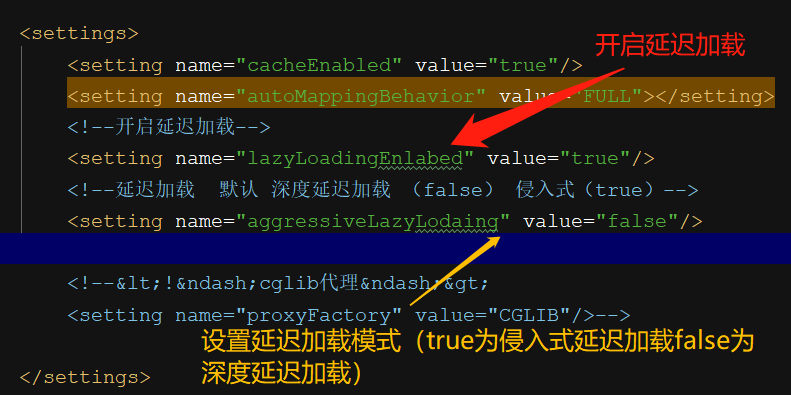
2.实体类:
1 package com.wdy.entity;
2
3 import javax.persistence.*;
4 import java.sql.Timestamp;
5 import java.util.List;
6
7
8 public class SmbmsRole {
9 private Integer id;
10 private String roleCode;
11 private String roleName;
12 private Long createdBy;
13 private Timestamp creationDate;
14
15 public SmbmsRole() {
16 }
17
18 @Override
19 public String toString() {
20 return "SmbmsRole{" +
21 "id=" + id +
22 ", roleCode='" + roleCode + '\'' +
23 ", roleName='" + roleName + '\'' +
24 ", createdBy=" + createdBy +
25 ", creationDate=" + creationDate +
26 ", users=" + users +
27 ", modifyBy=" + modifyBy +
28 ", modifyDate=" + modifyDate +
29 '}';
30 }
31
32 private List<SmbmsUser> users;
33
34 public SmbmsRole(Integer id, String roleCode, String roleName, Long createdBy, Timestamp creationDate, List<SmbmsUser> users, Long modifyBy, Timestamp modifyDate) {
35 this.id = id;
36 this.roleCode = roleCode;
37 this.roleName = roleName;
38 this.createdBy = createdBy;
39 this.creationDate = creationDate;
40 this.users = users;
41 this.modifyBy = modifyBy;
42 this.modifyDate = modifyDate;
43 }
44
45 private Long modifyBy;
46
47 public Integer getId() {
48 return id;
49 }
50
51 public void setId(Integer id) {
52 this.id = id;
53 }
54
55 public String getRoleCode() {
56 return roleCode;
57 }
58
59 public void setRoleCode(String roleCode) {
60 this.roleCode = roleCode;
61 }
62
63 public String getRoleName() {
64 return roleName;
65 }
66
67 public void setRoleName(String roleName) {
68 this.roleName = roleName;
69 }
70
71 public Long getCreatedBy() {
72 return createdBy;
73 }
74
75 public void setCreatedBy(Long createdBy) {
76 this.createdBy = createdBy;
77 }
78
79 public Timestamp getCreationDate() {
80 return creationDate;
81 }
82
83 public void setCreationDate(Timestamp creationDate) {
84 this.creationDate = creationDate;
85 }
86
87 public List<SmbmsUser> getUsers() {
88 return users;
89 }
90
91 public void setUsers(List<SmbmsUser> users) {
92 this.users = users;
93 }
94
95 public Long getModifyBy() {
96 return modifyBy;
97 }
98
99 public void setModifyBy(Long modifyBy) {
100 this.modifyBy = modifyBy;
101 }
102
103 public Timestamp getModifyDate() {
104 return modifyDate;
105 }
106
107 public void setModifyDate(Timestamp modifyDate) {
108 this.modifyDate = modifyDate;
109 }
110
111 private Timestamp modifyDate;
112
113 }
User实体类:
1 package com.wdy.entity;
2
3 import javax.persistence.*;
4 import java.sql.Date;
5 import java.sql.Timestamp;
6 import java.util.List;
7
8
9 public class SmbmsUser {
10 private Integer id;
11 private String userCode;
12 private String userName;
13 private String userPassword;
14 private Integer gender;
15 private Date birthday;
16 private String phone;
17 private String address;
18 private Integer userRole;
19 private Long createdBy;
20
21 @Override
22 public String toString() {
23 return "SmbmsUser{" +
24 "id=" + id +
25 ", userCode='" + userCode + '\'' +
26 ", userName='" + userName + '\'' +
27 ", userPassword='" + userPassword + '\'' +
28 ", gender=" + gender +
29 ", birthday=" + birthday +
30 ", phone='" + phone + '\'' +
31 ", address='" + address + '\'' +
32 ", userRole=" + userRole +
33 ", createdBy=" + createdBy +
34 ", creationDate=" + creationDate +
35 ", modifyBy=" + modifyBy +
36 ", modifyDate=" + modifyDate +
37 ", rolesList=" + rolesList +
38 '}';
39 }
40
41 private Timestamp creationDate;
42
43 public SmbmsUser(Integer id, String userCode, String userName, String userPassword, Integer gender, Date birthday, String phone, String address, Integer userRole, Long createdBy, Timestamp creationDate, Long modifyBy, Timestamp modifyDate, List<SmbmsRole> rolesList) {
44 this.id = id;
45 this.userCode = userCode;
46 this.userName = userName;
47 this.userPassword = userPassword;
48 this.gender = gender;
49 this.birthday = birthday;
50 this.phone = phone;
51 this.address = address;
52 this.userRole = userRole;
53 this.createdBy = createdBy;
54 this.creationDate = creationDate;
55 this.modifyBy = modifyBy;
56 this.modifyDate = modifyDate;
57 this.rolesList = rolesList;
58 }
59
60 private Long modifyBy;
61
62 public SmbmsUser() {
63 }
64
65 private Timestamp modifyDate;
66
67 public Integer getId() {
68 return id;
69 }
70
71 public void setId(Integer id) {
72 this.id = id;
73 }
74
75 public String getUserCode() {
76 return userCode;
77 }
78
79 public void setUserCode(String userCode) {
80 this.userCode = userCode;
81 }
82
83 public String getUserName() {
84 return userName;
85 }
86
87 public void setUserName(String userName) {
88 this.userName = userName;
89 }
90
91 public String getUserPassword() {
92 return userPassword;
93 }
94
95 public void setUserPassword(String userPassword) {
96 this.userPassword = userPassword;
97 }
98
99 public Integer getGender() {
100 return gender;
101 }
102
103 public void setGender(Integer gender) {
104 this.gender = gender;
105 }
106
107 public Date getBirthday() {
108 return birthday;
109 }
110
111 public void setBirthday(Date birthday) {
112 this.birthday = birthday;
113 }
114
115 public String getPhone() {
116 return phone;
117 }
118
119 public void setPhone(String phone) {
120 this.phone = phone;
121 }
122
123 public String getAddress() {
124 return address;
125 }
126
127 public void setAddress(String address) {
128 this.address = address;
129 }
130
131 public Integer getUserRole() {
132 return userRole;
133 }
134
135 public void setUserRole(Integer userRole) {
136 this.userRole = userRole;
137 }
138
139 public Long getCreatedBy() {
140 return createdBy;
141 }
142
143 public void setCreatedBy(Long createdBy) {
144 this.createdBy = createdBy;
145 }
146
147 public Timestamp getCreationDate() {
148 return creationDate;
149 }
150
151 public void setCreationDate(Timestamp creationDate) {
152 this.creationDate = creationDate;
153 }
154
155 public Long getModifyBy() {
156 return modifyBy;
157 }
158
159 public void setModifyBy(Long modifyBy) {
160 this.modifyBy = modifyBy;
161 }
162
163 public Timestamp getModifyDate() {
164 return modifyDate;
165 }
166
167 public void setModifyDate(Timestamp modifyDate) {
168 this.modifyDate = modifyDate;
169 }
170
171 public List<SmbmsRole> getRolesList() {
172 return rolesList;
173 }
174
175 public void setRolesList(List<SmbmsRole> rolesList) {
176 this.rolesList = rolesList;
177 }
178
179 private List<SmbmsRole> rolesList;
180
181
182 }
3.小配置文件
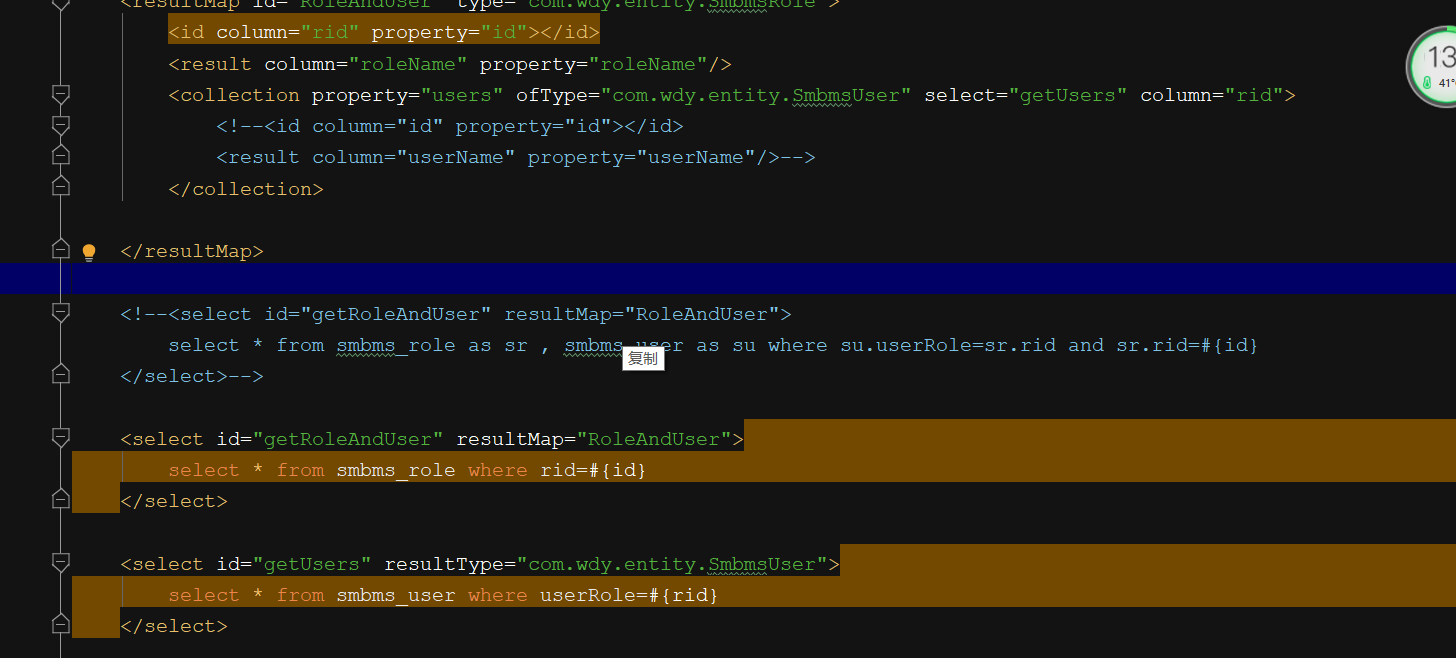
4.测试类
1 package com.wdy.test;
2
3
4
5 import com.wdy.dao.ISmbmsDao;
6 import com.wdy.entity.SmbmsRole;
7 import com.wdy.entity.SmbmsUser;
8 import com.wdy.util.SqlSessionUtils;
9 import org.apache.ibatis.session.SqlSession;
10 import org.junit.Test;
11
12 public class SmbmsUserTest {
13 @Test
14 public void getRoleAndUserTest(){
15 SqlSession session = SqlSessionUtils.getSession();
16 ISmbmsDao mapper = session.getMapper(ISmbmsDao.class);
17 SmbmsRole roleAndUser = mapper.getRoleAndUser(3);
18
19 System.out.println("职位:"+roleAndUser.getRoleName()+"\n人员:");
20 int xh=0;
21 for (SmbmsUser user:roleAndUser.getUsers()){
22 xh++;
23 System.out.print("\t序号"+xh+":"+user.getUserName()+"\n");
24 }
25
26
27 }
28
29 }
执行结果如下:
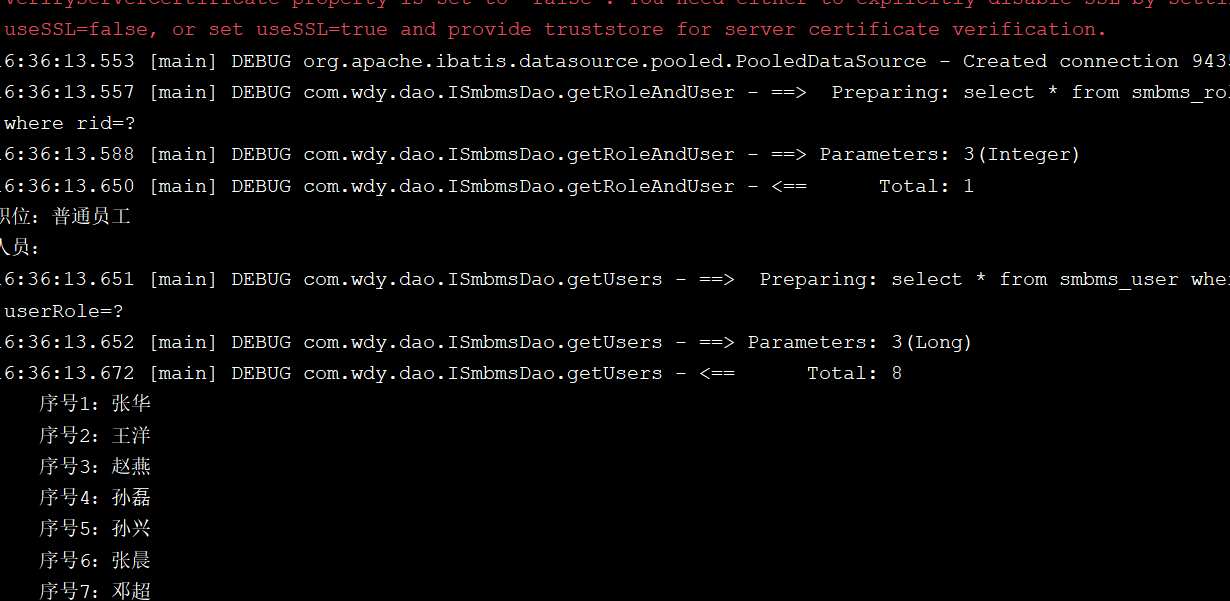
如果不访问关联对象的详细信息:
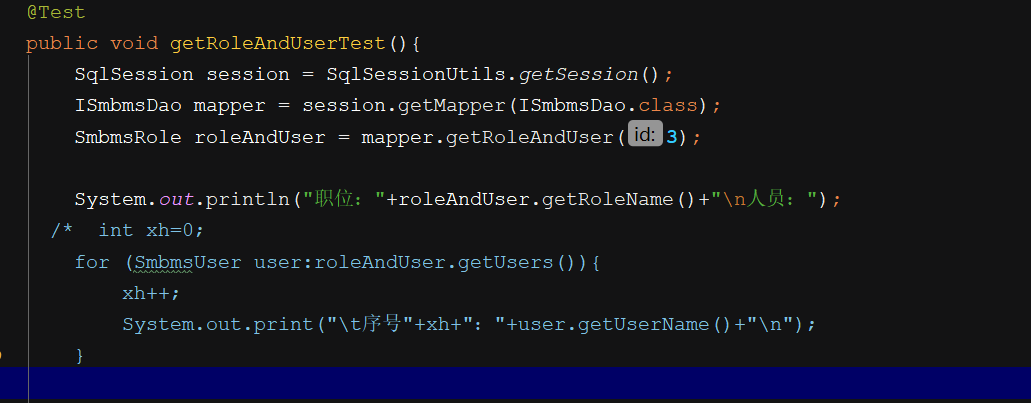
则 执行结果 只会执行主查询对象(只执行查询Role的select语句 也就是 职位 )
执行结果:

二.缓存
概述:
查询缓存的使用,主要是为了提高查询访问速度。将用户对同一数据的重复查询过程简化,不再每次均从数据库查询获取结果数据,从而提高访问速度。
二.一(一级缓存)
一.缓存的划分
根据缓存区的作用域与生命周期课划分为:
一级缓存(大配置文件setting节点name属性)

二.一级缓存存在证明
同一个会话(SqlSession)执行两次相同的SQL,观察控制台发送了几条SQL
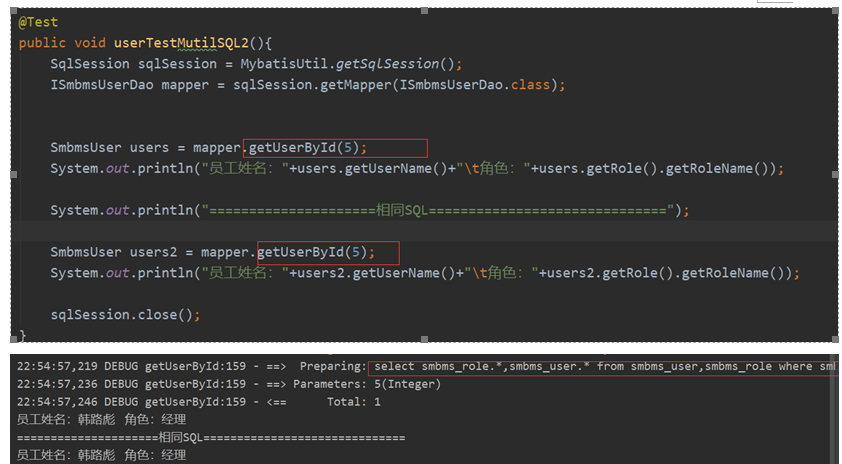
缓存的底层实现是一个Map,Map的key是查询的依据,使用的ORM框架不同,查询依据也不同,Mybatis查询依据为SQL的ID+SQL语句,hibernate的为查询结果对象的ID
三.增删改对一级缓存的影响

四.一级缓存结论
-
Mybatis框架天然集成一级缓存
-
一级缓存查询依据为SQLID+SQL语句
-
增删改会清空一级缓存
二.二(二级缓存)

二.缓存说明
MyBatis查询缓存的作用域是根据映射文件的namespace划分的,相同的namespace的mapper查询数据放在同一个缓存区域。不同namespace下的数据互不干扰。
无论是一级缓存还是二级缓存,都是按照namespace进行分别存放的。
一级、二级缓存的不同之处在于,SqlSession一旦关闭,则SqlSession中的数据将不存在,即一级缓存就不复存在。而二级缓存的生命周期与整个应用同步,与SqlSession是
否关闭无关。换句话说,一级缓存是在同一线程(同一SqlSession)间共享数据,而二级缓存是在不同线程(不同的SqlSession)间共享数据。
1.在大配置文件中开启二级缓存,默认为开启

2.在Mapper小配置文件中,添加缓存标签<cache/>
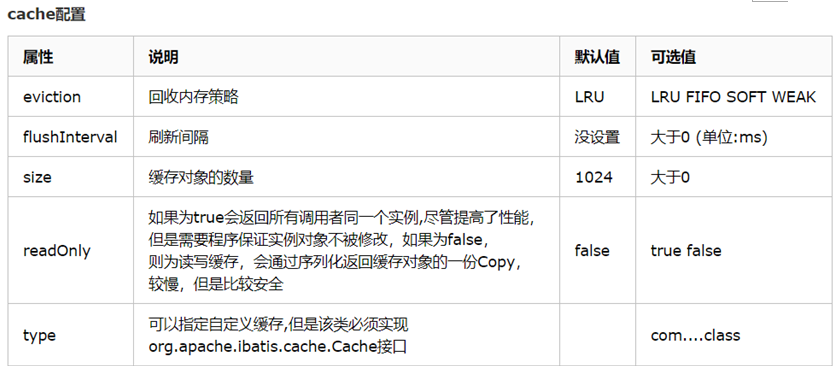

3.实体实现Serializable(标志接口:没有任何方法)

4.测试类
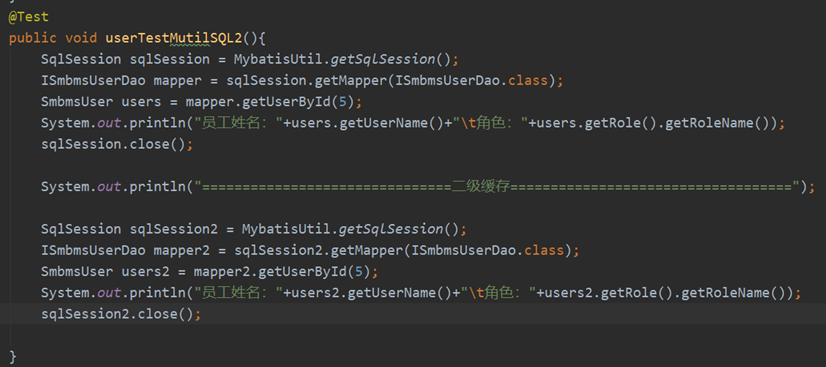
执行结果如下:

增删改对二级缓存的影响
增删改同样会清空二级缓存
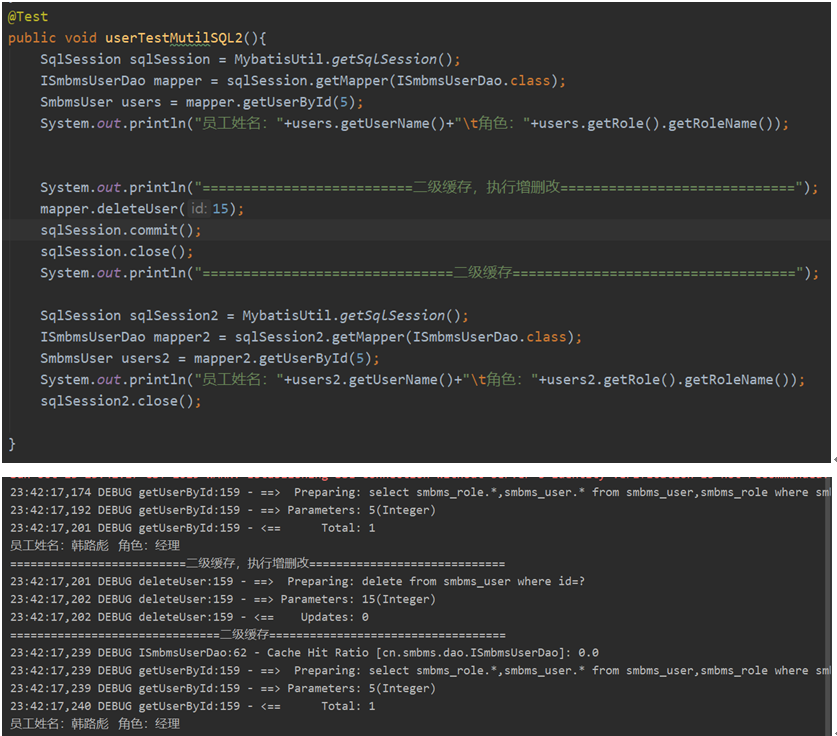
关闭刷新缓存(关闭后不再执行SQL查询)
在增删改对应小配置节点内,加入flushCache值为false

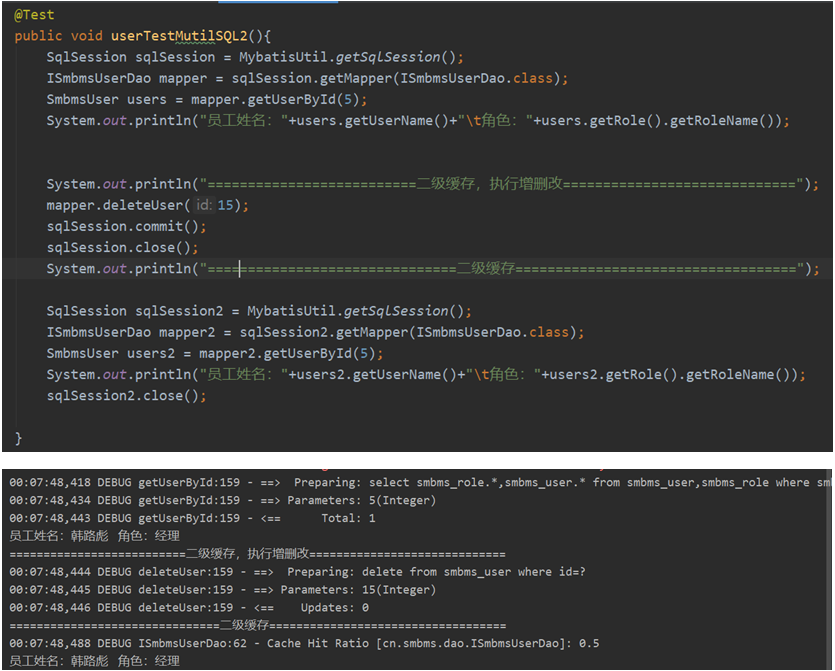
查询不应用缓存
不应用缓存代表会再次发送SQL查询数据
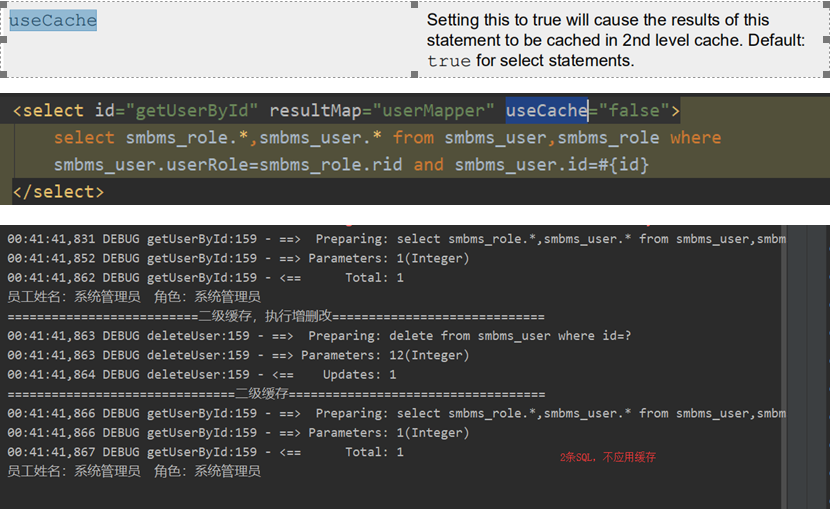
二级缓存: 在增删改情况下
如果提交事务会重新发送SQL执行数据库查询(清空缓存)。
如果不提交事务则获取缓存数据(不会重新发送SQL执行数据库查询(不清空缓存))。